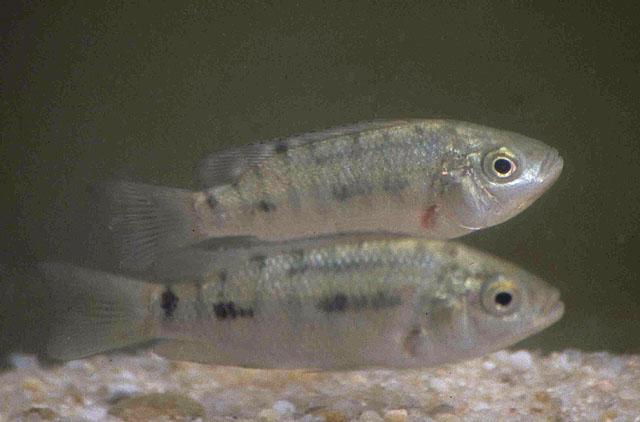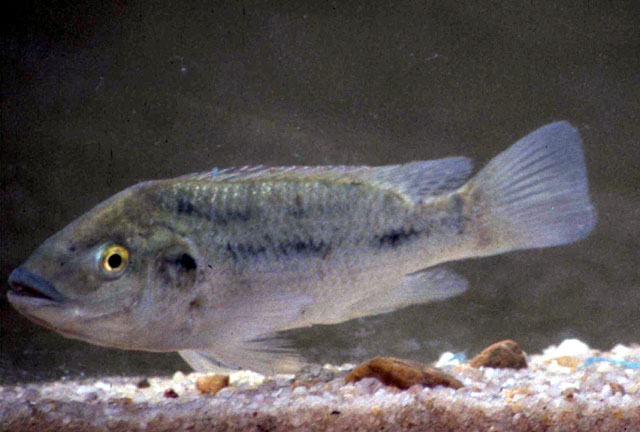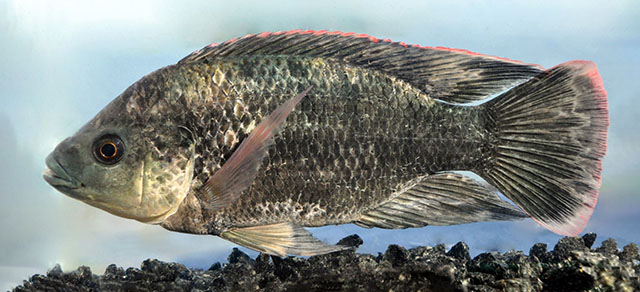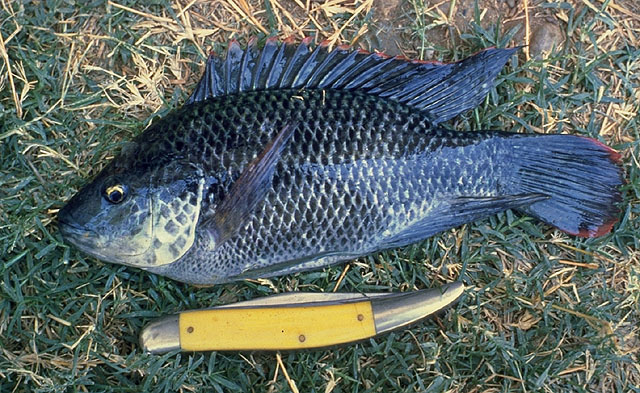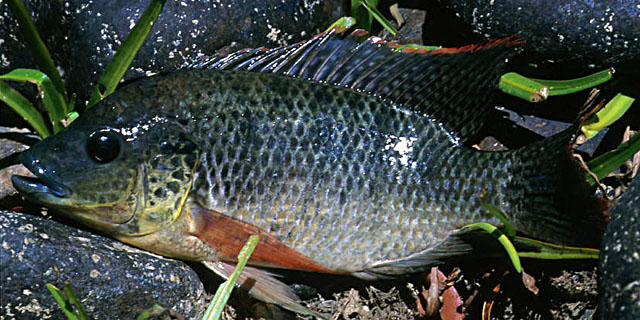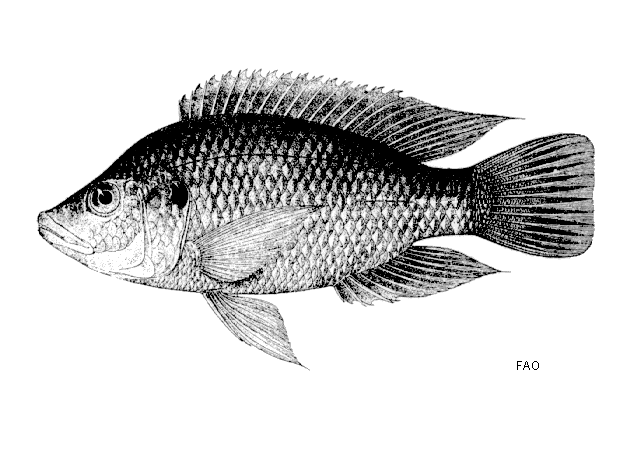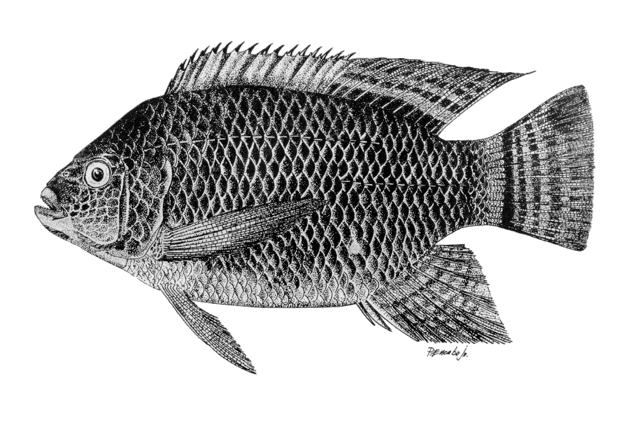Oreochromis
mossambicus
(Peters,
1852)
Mozambique tilapia
View all media / Upload your photos and videos
Expand all
Classification / Names
Teleostei (teleosts) > Cichliformes (Cichlids, convict blennies) >
Cichlidae (Cichlids)
> Pseudocrenilabrinae
Etymology: Oreochromis: Latin, aurum = gold + Greek, chromis = a fish, perhaps a perch (Ref. 45335).
mossambicus: From the Greek words oreos=of the mountains and chroma=color; mossambica describes the geographic area, Mozambique, to which the species is native (Ref. 79012).
More on author:
Peters.
Environment / milieu / depth range / climate zone / distribution range
Distribution
Africa: Lower Zambezi, Lower Shiré and coastal plains from Zambezi delta to Algoa Bay. Occurs southwards to the Brak River in the eastern Cape and in the Transvaal in the Limpopo system (Ref. 6465). Widely introduced for aquaculture, but escaped and established itself in the wild in many countries, often outcompeting local species (Ref. 12217). Several countries report adverse ecological impact after introduction.
Length at first maturity / Size / Weight / Age
Short description
Dorsal spines (total): 15 - 18; Dorsal soft rays (total): 10 - 13; Anal spines: 3; Anal soft rays: 7 - 12; Vertebrae: 28 - 31. Diagnosis: snout long; forehead with relatively large scales, starting with 2 scales between the eyes followed by 9 scales up to the dorsal fin (Ref. 3058, 3060). Adult males develop a pointed, duckbill-like snout (Ref. 52307) due to enlarged jaws, often causing the upper profile to become concave (Ref. 2, 7248, 12524, 13337, 52307), but upper profile convex in smaller specimens (Ref. 1870, 6460). Pharyngeal teeth very fine, the dentigerous area with narrow lobes, the blade in adults longer than dentigerous area; 28-31 vertebrae; 3 anal spines; 14-20 lower gill-rakers; genital papilla of males simple or with a shallow distal notch; caudal fin not densely scaled; female and non-breeding male silvery with 2-5 mid-lateral blotches and some of a more dorsal series; breeding male black with white lower parts of head and red margins to dorsal and caudal fins (Ref. 2). Description: moderately deep-bodied (Ref. 7248, 52307), but very variable according to food availability (Ref. 5214). Head profile straight in juveniles and females (Ref. 7248). Mouth large (Ref. 1870, 2989, 53262, 52307, 54167). Lower jaw prominent; lips thick (Ref. 3058, 3060). Maxillary ending between nostril and eye in females and immature males (Ref. 2), in breeding males (Ref. 2) mouth reaching to below anterior border of eye (Ref. 1870, 2989, 53262, 54167, 54759) or a little beyond (Ref. 1870, 2989, 53262, 54167). Eye with yellow ring around pupil (Ref. 57960). Otoliths: sulcus with nearly straight crista inferior at the transition between ostium and cauda (thus no ventralward widening of the ostium is present) (Ref. 56279). 2-3 series of scales on cheek (Ref. 2, 552, 1870, 2989, 3058, 3060, 6460, 53262, 54167). Scales cycloid (Ref. 1870, 2989, 3058, 4904, 5728, 53262, 54167). Scales on belly small, breast scales even smaller (Ref. 3058). Large scales on opercle (Ref. 1870, 53262), in 3 rows (Ref. 54759). 17-23 scales in upper part of lateral line, 10-17 in lower part (Ref. 1870, 2989, 3058, 54167). 9-12 predorsal scales (Ref. 57928). 15 precaudal vertebrae; 15-16 caudal vertebrae; 12-13 pairs of pleural ribs; 2 pairs of epineurals; 6 pairs of epipleurals; ventral vertebral apothysis on third vertebra (Ref. 57928). Gill-rakers short (Ref. 1870, 2989, 5214, 6465, 12524, 13337, 54167) and thick (Ref. 54167). Dorsal fin spines subequal from the sixth; dorsal soft rays a little longer than longest spines (Ref. 54167). Last dorsal spine the longest (Ref. 1870, 54167). Soft part of dorsal and anal fin long and pointed (Ref. 1870, 3058, 3060, 4904, 53262), especially in males (Ref. 44586). Dorsal fin with 25-28 pterygiophores (Ref. 57928). Pectoral fin (nearly) as long as head (Ref. 1870, 2989, 53262, 54167), pointed (Ref. 1870, 6460, 53262, 54759), reaching to vent (Ref. 6460, 54167) or to a little beyond origin of anal fin (Ref. 1870, 2989, 53262, 54167, 54759). 4-6 scales between bases of pectoral and pelvic fins (Ref. 2). Anal fin with 11-12 pterygiophores (Ref. 57928). Outer rays of pelvic fins slightly produced, reaching to vent (Ref. 1870, 54167) or beyond origin of anal (Ref. 1870, 2989). Caudal fin scaly in the basal half (Ref. 1870, 6460, 53262), the angles sometimes rounded (Ref. 2, 54167). Central caudal fin skeleton with 3 epurals, 5 hypurals and 2 pairs of uroneurals (Ref. 57928). No genital tassel (Ref. 55077). Coloration: basic melanin pattern of 2 horizontal and 6-7 vertical bars never fully realized; more commonly, at least in preserved specimens, females and sexually inactive males have no bands, but may have the intersection points of the facultative bands represented by 3-4 upper and 2-5 mid-lateral blotches, or some or all of these may be present (Ref. 2). Basic body coloration silvery grey (Ref. 2, 52307) to greenish grey, sometimes a more bluish colored head (Ref. 52307). Belly greyish (Ref. 4904, 5214, 54167). Spiny part of dorsal fin light with dark mottling (Ref. 3058). Soft dorsal and anal, and caudal and pelvic fins blackish (Ref. 2989, 3058, 3060, 54167). Pectoral fins colorless (Ref. 3058, 3060). Indistinct, dark opercular spot present (Ref. 1870, 2989, 3058, 3060, 53262, 54167, 54759). Vertical fins uniform (Ref. 54167), blackish with more or less distinct whitish spots(Ref. 552) or with large or small, fused or non-fused, dark spots on a pale background (Ref. 6460, 54167), given a darker aspect to these fins (Ref. 6460). 3 black blotches present in juveniles but possibly obscured in adults due to the dark body coloration of breeding males or old adults (Ref. 12524, 13337). Female and non-breeding male: dirty yellowish-olive (Ref. 12522) or silvery-gray, with 2-5 mid-lateral blotches and some of a more dorsal series (Ref. 2, 52307). Sometimes a series of more or less distinct spots along the side of the body above and below the upper lateral line (Ref. 54167). Breeding male: uniform dark olive-brown (Ref. 4904, 54167), deep blue-black (Ref. 2) or black, with white lower parts of head (Ref. 2, 4904, 7248, 54167), including throat, lower lips, lower parts of cheeks and opercles, but with a dark blue to black base to the throat (Ref. 12501, 52307), and red margins to dorsal and caudal fins (Ref. 2, 7248, 12522, 12501, 12524, 13337, 52307). Dorsal fin with light coloured spots on membrane between spinous and soft rays (Ref. 12524, 13337). Caudal fin olive-green with light coloured spots on anterior section (Ref. 12524, 13337), but may sometimes appear totally red (Ref. 52307). Tip of dorsal and extremity of caudal lobes yellowish (Ref. 4904, 54167). Anal fin dark gray (Ref. 52307) or olive-green (Ref. 12524, 13337), sometimes with a thin red/orange margin (Ref. 12501, 12522, 12524, 13337, 52307). Unpaired fins normally exhibit greenish to silvery iridescent dots (Ref. 52307). Pectoral fin rays red (Ref. 2). Pectoral and pelvic fins olive-yellow (Ref. 12524). Juveniles: body silvery (Ref. 2, 5214, 6465, 7248, 12524, 13337, 55020, 57960) or olive-brown, light on belly (Ref. 54167). Scales with dark outer edge (Ref. 54167). Usually 5-8 or more indistinct dark cross bars on body (Ref. 2, 6460, 7248, 39866, 54167, 55020), often in addition to the 2 series of blackish spots (Ref. 54167), but with no horizontal stripes (Ref. 2). Dark opercular spot (Ref. 6460, 54167), on posterior dorsal edge of operculum (Ref. 55020). Black spot at base of anterior rays of soft dorsal (Ref. 552, 54167) and 1-2 whitish spots enclosed by dark streaks (Ref. 54167). Oblique streaks (Ref. 6460) or translucent round spots (Ref. 55020) on soft dorsal. Anal dark at base with a light outer half (Ref. 54167), with oblique streaks (Ref. 6460). Caudal dark at base, light in centre, a black outer ridge (Ref. 54167), with 2-3 bars across the fin (Ref. 6460). Tilapia-spot present (Ref. 2, 5214, 6465, 12501), conspicuous in younger fish persisting albeit faintly to 8cm (Ref. 55020). Fins flesh coloured (Ref. 12524, 13337), all except soft dorsal immaculate (Ref. 55020).
Biology
Adults thrive in standing waters (Ref. 7248, 12501). Inhabits reservoirs, rivers, creeks, drains, swamps and tidal creeks; commonly over mud bottoms, often in well-vegetated areas (Ref. 44894). Also found in warm weedy pools of sluggish streams, canals, and ponds (Ref. 5723). Most common in blind estuaries and coastal lakes (Ref. 32693), but usually absent from permanently open estuaries and open sea (Ref. 6465) and from fast-flowing waters (Ref. 7248, 12501). Normally not found at high altitudes (Ref. 6465). Able to survive extreme reduction of temporary water bodies (Ref. 2, 27445). Highly euryhaline (Ref. 2, 3, 23, 58, 61, 6465, 12501, 12522, 12524, 13337, 27445, 55352). Grows and reproduces in fresh-, brackish and seawater (Ref. 2, 21, 23, 61, 5214, 27445, 36683, 54362). Can be reared under hyper-saline conditions (Ref. 4537, 44894, 52307). Tolerates low dissolved oxygen levels (Ref. 3, 23, 6465) and can utilise atmospheric oxygen when water oxygen levels drop (Ref. 61, 6465). Mainly diurnal. May form schools (Ref. 3, 4537, 44894). Omnivorous (Ref. 21, 12524), feeds mainly on algae and phytoplankton (Ref. 4537, 7248, 12501, 12522, 12524, 13337, 36683, 44894, 52307) but also takes some zooplankton, small insects and their larvae (Ref. 4537, 7248, 12524, 13337, 44894, 52307), shrimps (Ref. 12524, 13337), earthworms (Ref. 12501) and aquatic macrophytes (Ref. 6465). Juveniles carnivorous/omnivorous, adults tend to be herbivorous or detritus feeders (Ref. 2, 6465, 13517). Large individuals have been reported to prey on small fishes (Ref. 2, 6465, 12501, 12522), and occasionally cannibalise their own young (Ref. 2, 6465). Exhibits considerable plasticity in feeding habits (Ref. 6465, 13544) as well as in reproductive biology (Ref. 13544). Polygamous (Ref. 12524, 13337), maternal mouthbrooder (Ref. 1, 5214, 12524, 13337). Reaches sexual maturity at 15 centimeter length (Ref. 44894), but stunted fish may breed at 6-7 centimeters and at an age of just over 2 months (Ref. 52307). Fecundity high (Ref. 55352). Extended temperature range 8-42 °C, natural temperature range 17-35°C (Ref. 3), with salinity-dependent difference in temperature tolerance (Ref. 2, 23). Somewhat aggressive toward other species (Ref. 36683). Marketed fresh and frozen (Ref. 9987). Excellent palatability (Ref. 6465), with small head and large dress-out weight (Ref. 61), and filets without small bones (Ref. 57960). Used extensively in biological, physiological and behavioural research (Ref. 7248). Translocated and introduced for aquaculture, sport fishing, stocking man-made lakes and biological control of nuisance plants and animals (Ref. 6465). Eurytopic; a most successful and vagile invader (Ref. 6465).
Life cycle and mating behavior
Spawns at the edge of the littoral terrace of lakes (Ref. 1, 2, 87, 6465), in sandy or muddy bottoms (Ref. 57425). Displays a lek mating system; territorial males establish breeding territories where they dig spawning pits, assume a dark coloration, defend a breeding territory and actively court females; sneaking males intrude into nests during a spawning episode, exhibiting quivering behavior which is usually an indicator of sperm release; sneaking is predominantly performed by subordinate males, which may adopt pseudo-female behavior (Ref. 57425). Only territorial males produce sounds, during all phases of courtship but especially during the late stages, including spawning (Ref. 49830). Territorial male excavates and defends a basin-shaped pit in the center of his territory, where female deposits 100-1700(1800) eggs (Ref. 44894, 52307). Eggs and milt are sucked up by the female (Ref. 2, 44894). Fertilization is reported to sometimes occur in the mouth of the female (Ref. 6028). Females incubate eggs alone (Ref. 12501, 52307). It is possible, albeit rare, that males take up some eggs after spawning (Ref. 2, 5726, 52307, 57895), but they almost always eat them soon after (Ref. 52307). Females school together while mouthbrooding (Ref. 40035), they cease to feed and subsist on food reserves stored in their body (Ref. 1). Females may spawn a full clutch with just one male, or may spawn with several different males in a series (Ref. 52307). Water is circulated over the eggs by chewing movements of the jaws (Ref. 12501, 12522). Fry hatch in the female's mouth after 3-5 days (Ref. 2, 12501, 12522, 44894, 52307), depending on the temperature (Ref. 52307). The young are released from the mouth in 10-14 days, but remain near the female and enter the mouth if threatened until about 3 weeks old (Ref. 2, 44894, 52307). Fry and juveniles shoal in shallow water (Ref. 6465, 7248, 57895) where they feed during the day, and retreat to deep water at night (Ref. 87, 6465). Females raise multiple broods during a season (Ref. 7248, 57895).
Main reference
Trewavas, E. 1982 Tilapias: taxonomy and speciation. p. 3-13. In R.S.V. Pullin and R.H. Lowe-McConnell (eds.) The biology and culture of tilapias. ICLARM Conf. Proc. 7. (Ref. 1)
IUCN Red List Status (Ref. 125652)
Vulnerable (VU), A4ae; date assessed: October 02 2017
CITES (Ref. 123416)
Not Evaluated
CMS (Ref. 116361)
Not Evaluated
Threat to humans
Potential pest
More information
- Countries
- FAO areas
- Ecosystems
- Occurrences
- Introductions
- Stocks
- Ecology
- Diet
- Food items
- Food consumption
- Ration
- Common names
- Synonyms
- Metabolism
- Predators
- Ecotoxicology
- Reproduction
- Maturity
- Spawning
- Spawning aggregation
- Fecundity
- Eggs
- Egg development
- Age/Size
- Growth
- Length-weight
- Length-length
- Length-frequencies
- Morphometrics
- Morphology
- Larvae
- Larval dynamics
- Recruitment
- Abundance
- References
- Aquaculture
- Aquaculture profile
- Strains
- Genetics
- Allele frequencies
- Heritability
- Diseases
- Processing
- Mass conversion
- Vision
- Pictures
- Stamps, Coins Misc.
- Sounds
- Ciguatera
- Speed
- Swim. type
- Gill area
- Otoliths
- Brains
Estimates based on models
Phylogenetic diversity index (Ref. 82804): PD50 = 0.5 [Uniqueness, from 0.5 = low to 2.0 = high].
Bayesian length-weight: a=0.01862 (0.01473 - 0.02354), b=2.98 (2.94 - 3.02), in cm total length, based on LWR estimates for this species (Ref. 93245).
Trophic level (Ref. 69278): 2.2 ±0.0 se; Based on diet studies.
Generation time: 3.1 (2.8 - 4.1) years. Estimated as median ln(3)/K based on 28 growth studies.
Resilience (Ref. 120179): Medium, minimum population doubling time 1.4 - 4.4 years (K=0.2-0.5; tm<1; tmax=11).
Fishing vulnerability (Ref. 59153): Low to moderate vulnerability (34 of 100).
Price category (Ref. 80766): Unknown.
Nutrients (Ref. 124155): Calcium = 22 [8, 101] mg/100g; Iron = 1.05 [0.52, 2.32] mg/100g; Protein = 17.9 [16.4, 19.7] %; Omega3 = 0.197 [0.097, 0.429] g/100g; Selenium = 43.3 [23.9, 82.5] μg/100g; VitaminA = 10.8 [2.6, 38.7] μg/100g; Zinc = 1.82 [1.07, 4.29] mg/100g (wet weight); based on nutrient studies.

